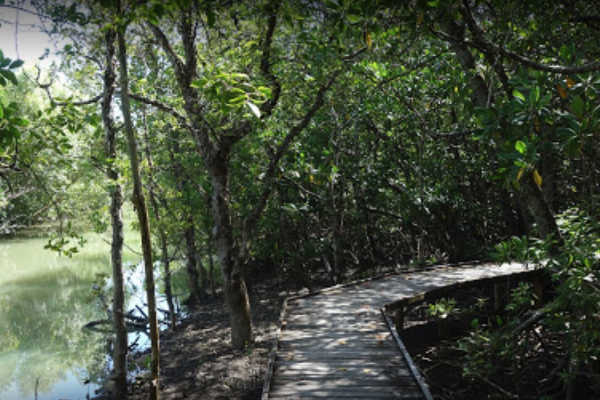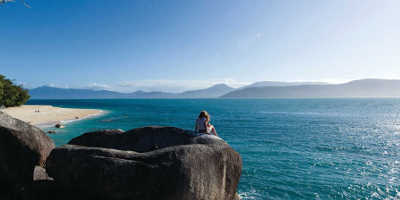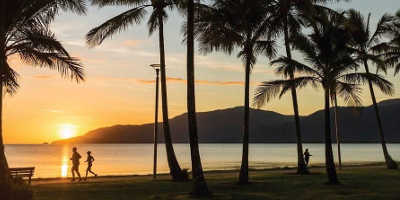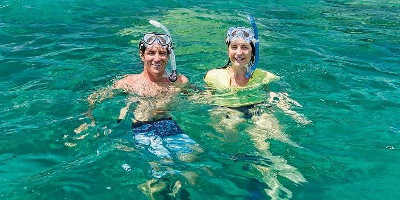Mangrove Boardwalk, Cairns
Mangroves are an important ecosystem that help protect the land from the sea and vice versa, providing a home for many young reef fish in the area.
The Cairns mangroves are a classic example of mangrove life, where the trees themselves have evolved over time to thrive permanently in a mixture of salt and freshwater that is forever changing.
About the Mangroves
-
The Mangroves’ Physical Appearance
There are roughly around 80 different species of mangroves, with Queensland having 34 species within its seacoasts. Despite these many varieties, the mangroves can still be easily recognised. Always featuring a dense tangle of prop roots that emerge from a wet region, whether it be the shallow seawater or a swamp. The roots are submerged in the water, with their thick roots sticking out in the air, creating a maze of branches and leaves.
-
The Mangroves’ Habitat
They typically occur throughout the tropics, with Queensland having the largest mangrove population out of all of Australia. Inhabiting sheltered shores, characteristically in estuaries and lagoons, in sandy, rocky, or coral environments. All mangrove plants must have their roots absorbed in a dense moisture environment, but sometimes rather than water, it is merely swamp. However, due to flooding and the wet season of Queensland, all mangrove roots rest in a layer of water at some point. Due to the region being thick in moisture, it is a hub for insects, which brings a heard of predators.
What makes them Unique
To put it simply, they are survivors. Thriving in hot, muddy, salty conditions, with the plants flooded with water twice a day. This typically would quickly kill most plants, but the mangroves have evolved thoroughly, with a series of adaptations that help with this rough habitat.
One of the main adaptations is its filtration system. As the seawater they live in, the oxygen is overpowered by the salt. Therefore the exposed roots above the water absorb the oxygen from the air, transporting it down towards the roots. These trees then get rid of the salt by storing it certain leaves, which eventually turn yellow and die.
Another complex adaptation is the mangroves extensive root system. With the tangles helping hold the mangrove upright and stable. This is particularly important for when the sea is rough, or during the low/high tide. With the roots acting as a stabiliser to hold the plant erect in soft mud.
Mangroves as Ecosystems
Due to the mangroves unique habitat and ability to expand quite a distant, the mangrove ecosystem supports an incredibly diverse range of creatures. With the mangrove swamps an extremely significant to the health of the planet. They act as a bridge between the sea and land, with both marine and land animals existing within.
Playing host to a huge collection of creatures that each have their own special place in the ecosystem. Including 70 different species of crustaceans, 70 types of fish, and over 230 species of birds. Expect to see quirky species like fish that can live outside of the water, fighting crabs, and baby sharks.
The food system for each species living within all depends on the mangroves. With the decaying leaves of the plants providing nourishment to the algae. Which in turn feeds the crabs, prawns, and other crustaceans. The larger fish eat these crustaceans, who are eaten by the birds or mammals.
Mangrove Boardwalk
At the heart of the mangrove system in Cairns, you’ll find the Jack Barnes Bicentennial Mangrove Boardwalk, where you can learn all about the unique, tropical mangroves and saltmarshes of Australia.
As you move along the boardwalk, you can learn all about the incredible abundance of wildlife that lives in the region and discovers what the purpose of the mangroves and other tidal wetland systems are. As you discover this area, you can see 11 different mangrove species.
-
The Northern Side of the Mangrove Boardwalk
Split into two parts, the boardwalk heads north or south into closed-off mangrove forests that sprawl out in every direction from the carpark. If you head north, you can make your way too Little Barron Creek, where there are plenty of viewing platforms at the edge of the creek which promises stunning views across the surrounding landscape. There is also a range of informational signs displayed throughout the paths, detailing the history and inhabitants of the region.
Halfway along this stretch of the boardwalk, you’ll come across a canopy tower that looks out across the lush velvet carpet of treetops. This section of the boardwalk is a circular route and takes you from the carpark through the mangrove forests and back to the carpark, with signs along the way that give extra information on the plants and animals that have adapted over thousands of years to live in this unique environment.
-
The Southern Side of the Mangrove Boardwalk
If you head along the southern part of the boardwalk, you’ll have a slightly different experience, where you’ll get to see a few different kinds of mangrove forest. Unlike the northern part of the boardwalk, this part isn’t a circular route and instead terminates at a canopy tower near to the mouth of Swampy Creek. As you explore this part of the region, helpful signs will let you in on the productivity of mangrove forests and other fascinating facts.
If you’re looking to explore a different side of Australia’s unique wildlife, the mangroves are the perfect place to go. Not only will you learn about this unique ecosystem, but you can catch a glimpse of some of the more unusual species in the country.










